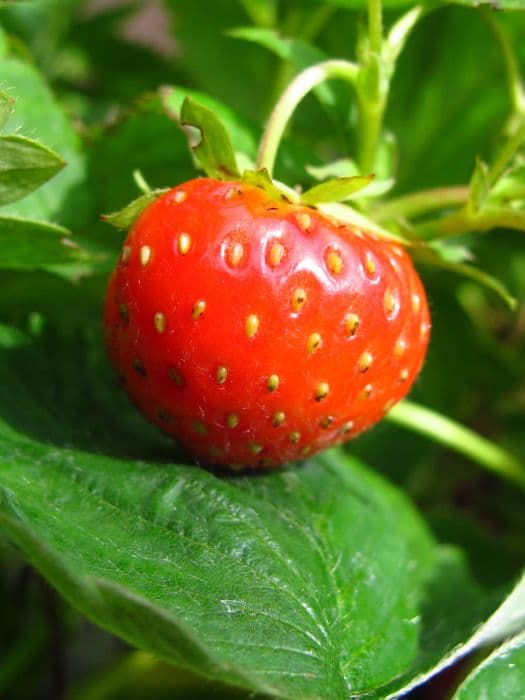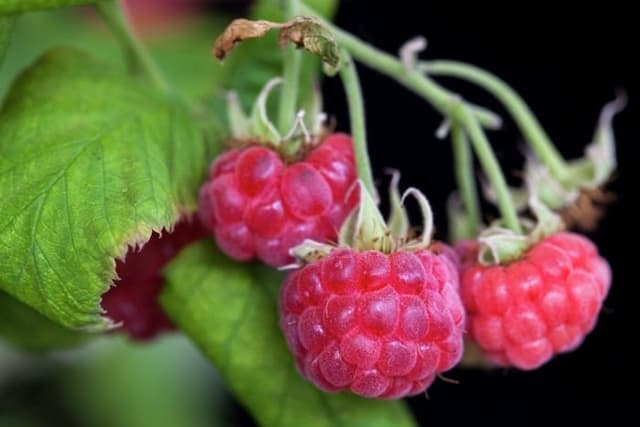Damask Rose Rosa 'Celsiana' (D)

ABOUT
Rosa 'Celsiana' is a type of Old Garden Rose known for its charming and romantically styled blooms. The flowers are semi-double, meaning they have a slightly fuller appearance than single roses but are not as packed with petals as fully double roses. Each bloom consists of numerous soft pink petals that gracefully open to reveal a classic, flat rosette shape. The color of the petals can be described as a delicate pastel pink, which may exhibit a more intense hue at the center, fading towards the petal edges. At the heart of each bloom, there is a prominent display of golden-yellow stamens, creating an eye-catching contrast against the soft pink petals. This combination of colors adds to the visual appeal of the rose and is one of its distinguishing features. The overall effect of Rosa 'Celsiana' flowers is nostalgic and evocative of English cottage gardens. Rosa 'Celsiana' foliage is also noteworthy, as it comprises lush, green leaves that have a slightly matte finish and a soft, leathery texture. The leaves provide a verdant backdrop that highlights the delicacy and color of the blooms. The plant's growth habit is typical of many Old Garden Roses, with a bushy and somewhat arching form that adds to its naturalistic and slightly informal charm. The stems of this rose may bear thorns. The plant's aesthetics and flowering contribute to its desirability, with the blossoms characteristically appearing in flushes throughout the growing season. Rosa 'Celsiana' is appreciated for its beauty and the gentle fragrance the flowers exude, which is reminiscent of classic rose scents, adding to the sensory pleasures of this enchanting garden favorite.
About this plant
 Names
NamesFamily
Rosaceae
Synonyms
Damask Rose, Celsiana
Common names
Rosa 'Celsiana' (D).
 Toxicity
ToxicityTo humans
Rosa 'Celsiana' is commonly known as Damask rose. Damask roses are not considered poisonous to humans. These plants do not typically cause adverse reactions when touched or ingested in small amounts. However, like any plant material, eating large quantities could potentially cause stomach upset due to the fiber content and natural compounds present. It is always advisable to avoid eating ornamental plants as a general safety rule.
To pets
Damask rose is the common name for Rosa 'Celsiana'. This plant is not toxic to pets such as cats and dogs. However, rose bushes have thorns that can cause physical injury if pets attempt to chew on the stems. The ingestion of rose petals in small quantities is typically not harmful, but consumption of large amounts of plant material may lead to gastrointestinal upset, such as vomiting or diarrhea. It's a good practice to discourage pets from chewing on ornamental plants as a precaution.
 Characteristics
CharacteristicsLife cycle
Perennials
Foliage type
Deciduous
Color of leaves
Green
Flower color
Pink
Height
4 feet (1.2 meters)
Spread
3 feet (0.9 meters)
Plant type
Shrub
Hardiness zones
4
Native area
Europe
Benefits
 General Benefits
General Benefits- Attracts pollinators: Rosa 'Celsiana' (Damask rose) serves as a valuable food source for bees and other beneficial insects.
- Historical significance: Damask roses are known for their importance in the history of perfumery and gardening, offering cultural and educational interest.
- Aesthetic appeal: With its abundant and attractive pale pink flowers, the Damask rose can enhance the visual beauty of gardens and landscapes.
- Fragrance: The Damask rose is celebrated for its distinct and pleasant fragrance, contributing to sensory garden experiences.
- Hardiness: It is a resilient plant that can thrive in a variety of soil types and conditions, requiring minimal maintenance once established.
- Biodiversity support: As a host to pollinators and other wildlife, Damask roses can play a role in maintaining and supporting local biodiversity.
- Habitat enrichment: The Damask rose can serve as part of a habitat for small wildlife, providing shelter and food sources.
- Culinary uses: The petals of the Damask rose are edible and can be used to flavor foods, syrups, and teas, enhancing culinary creations.
- Traditional uses: Historically, Damask roses have been used in various cultural practices and ceremonies, enriching the value of gardens that grow them.
- Erosion control: The root systems of perennial plants like roses can help to stabilize soil and prevent erosion in certain settings.
- Seasonal interest: The Damask rose offers a display of blooms in the spring and summer, followed by attractive rose hips in the autumn.
 Medical Properties
Medical PropertiesThis plant is not used for medical purposes.
 Air-purifying Qualities
Air-purifying QualitiesThis plant is not specifically known for air purifying qualities.
 Other Uses
Other Uses- Rosa 'Celsiana' petals can be used in crafting natural dyes for textiles, providing a range of colors from light pink to a deep rose hue depending on the mordant used.
- Petals of the rose can be included in paper-making for creating decorative, fragrant, and textured handmade papers.
- Rosehips, which are the fruit of Rosa 'Celsiana', can be used to make herbal teas that have a delicate, fruity flavor, after they have been dried and crushed.
- The rose's strong fragrance makes its dried petals ideal for creating potpourris and natural sachets that freshen up linens and wardrobes.
- The essential oils derived from Rosa 'Celsiana' can be used in aromatherapy for their calming and uplifting properties.
- Its petals are edible and can be candied for garnishing desserts or incorporated into rose-flavored syrups and jellies.
- Dense shrubbery of Rosa 'Celsiana' can provide natural habitat and protective cover for small wildlife in gardens.
- Rose flowers can be used in floral arrangements and bouquets for their classic beauty and scent.
- When infused in water, rose petals can serve as a natural facial toner for skin care routines.
- The rose's sturdy stems, when pruned, can be formed into natural supports or trellises for other climbing plants in the garden.
Interesting Facts
 Feng Shui
Feng ShuiThe Damask Rose is not used in Feng Shui practice.
 Zodiac Sign Compitability
Zodiac Sign CompitabilityThe Damask Rose is not used in astrology practice.
 Plant Symbolism
Plant Symbolism- Love: As with many roses, the Rosa 'Celsiana', commonly known as the Damask Rose, often symbolizes love and admiration. Its beauty and fragrance have been associated with romantic sentiments since ancient times.
- Beauty: The Damask Rose is acclaimed for its exquisite form and splendid bloom, making it a symbol of beauty and perfection in various cultures.
- Nostalgia: Due to its historic cultivation and use in traditional perfumery, the Damask Rose can evoke a sense of nostalgia and a connection to the past.
- Secrecy: Tied to the ancient Roman practice of placing a wild rose on the door of a meeting room, the term "sub rosa" (under the rose) signifies confidentiality, with the rose symbolizing secrecy and silence.
 Water
WaterThe common name for Rosa 'Celsiana' is Damask Rose. It should be watered deeply to ensure the roots receive enough moisture, usually amounting to about 1 to 1.5 gallons per plant, depending on the size and weather conditions. During the growing season, watering once a week is often sufficient, but in times of drought or extremely hot weather, you might need to water twice a week. It's important to avoid overhead watering to prevent disease; always water at the base of the plant. The soil surrounding the Damask Rose should be kept moist but never soggy to prevent root rot.
 Light
LightDamask Roses thrive best in full sun conditions, requiring at least 6 to 8 hours of direct sunlight per day. Placing them in a spot that receives morning sun is particularly beneficial as it helps dry the dew on the leaves, reducing the risk of diseases. However, they can tolerate partial shade, especially in regions with very hot summers, but blooming may be reduced in less than ideal light conditions.
 Temperature
TemperatureDamask Roses are hardy and can survive in a wide range of temperatures but perform best when daytime temperatures are between 65 and 75 degrees Fahrenheit. They are capable of withstanding short periods of colder weather down to around 20 degrees Fahrenheit and can manage heat above 90 degrees Fahrenheit, provided they are well-watered and mulched.
 Pruning
PruningPruning Damask Roses helps maintain their shape, encourages new growth, and improves air circulation which can reduce disease occurrence. Prune in early spring after the last frost, removing dead or weak canes, and cutting back about one-third of the previous year's growth to stimulate blooming. Deadheading, or removing spent flowers, should be done consistently throughout the blooming season to encourage repeat flowering.
 Cleaning
CleaningAs needed
 Soil
SoilDamask Rose prefers well-draining loamy soil enriched with organic matter, such as compost or aged manure. A slightly acidic to neutral pH between 6.0 and 7.0 is ideal for optimal growth.
 Repotting
RepottingDamask Rose does not typically require frequent repotting, as it is usually grown in the ground. If grown in a container, repot every 2-3 years to refresh the soil and provide more space for roots.
 Humidity & Misting
Humidity & MistingDamask Rose thrives in average outdoor humidity levels; it does not require special humidity conditions different from typical garden environments.
 Suitable locations
Suitable locationsIndoor
Place in bright, indirect light and ensure good air circulation.
Outdoor
Plant in full sun, ensure well-draining soil, add mulch.
Hardiness zone
4-9 USDA
 Life cycle
Life cycleRosa 'Celsiana', commonly known as Celsiana Damask Rose, begins its life cycle with seed germination, although they are more commonly propagated by grafting or cuttings. The young plant then develops a root system and foliage as it enters the vegetative stage. Over time, it matures and enters the flowering stage, usually in late spring to early summer, producing fragrant, light pink blossoms that attract pollinators. After pollination, it produces hips (fruit) which contain seeds, completing its reproductive cycle. As a perennial, the Celsiana Damask Rose will enter a period of dormancy in the winter, wherein it loses leaves and conserves energy. With the return of warmer weather, the rose re-enters the vegetative stage, creating new shoots and leaves, and the cycle repeats.
 Propogation
PropogationPropogation time
Spring-Early Summer
Rosa 'Celsiana', commonly known as Old Damask Rose, can be propagated most effectively via softwood cuttings, a popular method for many rose cultivars. The ideal time for this process is late spring to early summer when the plant's new growth is mature enough to be pliable yet young enough to root readily. To propagate, one should select a healthy stem with several leaves, cutting a length of about 6 to 8 inches (15 to 20 centimeters) just below a leaf node. It's important to remove the leaves from the lower half of the cutting to prevent moisture loss. The cut end of the stem is then dipped into rooting hormone and placed in a well-draining soil mix. Maintaining high humidity around the cuttings by covering them with a plastic bag or placing them in a greenhouse will help encourage rooting. Root development can take several weeks, after which the new plants can be gradually acclimatized to outdoor conditions before planting in their permanent location.









